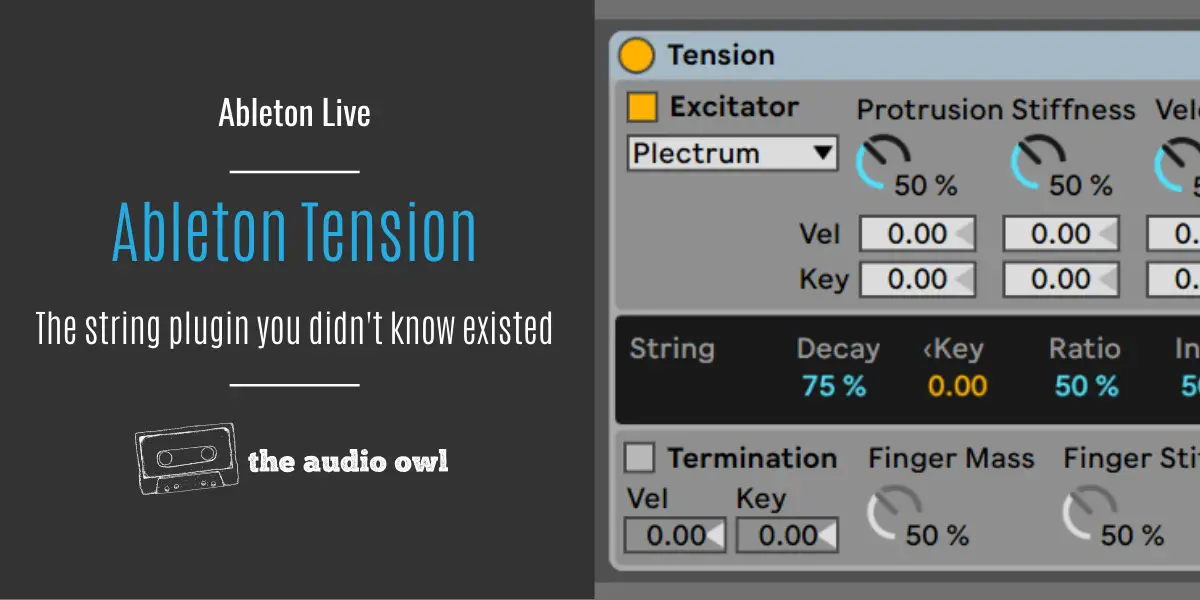String instruments are often needed, but hard to replicate in the digital world. Fortunately for Ableton Live users, Ableton Tension exists. A physical modeling synth that replicates the sound of strings to a T. From the plucking, to the resonating, Tension is a comprehensive string modeler.
In this article, we are going to talk about Tension and how it works. Obviously…
What Does Tension Do?
Tension is Ableton Lives string instrument emulation synthesizer.
This synth was created in collaboration with Applied Acoustics Systems (AAS) which have partnered with Ableton on other projects such as Collision.
Tension can emulate the characteristics of stringed instruments. Everything from the strings, body, frets, fingers, and pickups, as well as how the string is played. Whether it is with a pick, bow, or hammer. This allows you to recreate a wide variety of stringed instruments and textures.
How To Use Tension
Tension does not look very fun at first. But, when you take the time to get to know the parameters, it becomes a powerful music production tool.
Tension features four types of string excitators: two types of hammer, a pick, and a bow.
There is also an accurate model of a string, a model of the fret/finger interaction, a damper model, and different types of soundboards. Tension thought of every touchpoint a stringed instrument would have and included controls for them.
The combination of these different elements allows for the reproduction of a wide range of string instruments.
Tension is also equipped with filters, LFOs, and envelope parameters that extend the sound sculpting possibilities.
This string emulation device creates beyond what would be possible with sample-based instruments and real instruments.
Finally, Tension offers a wide range of performance features, including keyboard modes, portamento, vibrato, and legato functions.
Excitator
The excitator of Tension is different from the other excitators we’ve seen in Collision. This excitator is unique to Tension and it models different techniques for playing strings. Think of the excitator as different ways to pluck or vibrate the string.
Excitator Types
The different excitators you can find in Tension are as follows:
Bow – simulates a violin bow drawn against strings.
Hammer – simulates a soft mallet striking a string from underneath.
Hammer (bouncing) – simulates a hammer striking a string from above.
Plectrum – simulates a pick similar to how you would play guitar.
Excitator Parameters
To modify how the excitator acts there are several parameters we can use.
Bow
The parameters for the Bow excitator are:
Bow force: Adjusts the amount of pressure being applied to the string by the bow.
Bow friction: Adjusts the amount of friction between the bow and the string. The more friction that’s applied the tighter the sound will be.
Hammer
The parameters for the Hammer excitator are:
Hammer mass: Sets the mass of the hammer.
Hammer stiffness: Adjusts the stiffness of the hammer’s surface area. The sound reminds me of a lowpass filter.
The parameters for the Hammer (bouncing) excitator are:
Same as the regular “hammer” parameter.
Plectrum
The parameters for the Plectrum excitator are:
Protrusion: Sets how much of the plectrum’s surface area is placed under the string. Higher settings result in a pluckier sound with more attack.
These parameters are unique to its excitators, but there are three more parameters that you can find are mutual to all excitators and those are:
Velocity – adds velocity control to the excitator.
Position – This sets the position on the string at which the excitator will make contact.
Damping: Adjusts how much of the excitator’s impact force is absorbed by the excitator itself.
Damper
Damper works similarly to the damper on the hammer excitator and you can even find the same parameters. The only difference is that the Damper’s velocity parameter is turned on if you enable the gate switch.
When the gate switch is enabled, the effects of Damper only start to affect the sound when you release a key.
String
The String section contains parameters related to how the string of Tension will behave.
Parameters of the string section affect the decay of the string and the inharmonic quality of the string when played.
In a real-world scenario when a string is struck it will vibrate for some time. The strike of the excitator will create a slight detuning of the string which Tension emulates.
On the right side of the string section, you will also find the vibrato effect which can be enabled with a switch. The vibrato effect emulates the technique of applying pitch modulation by hand when playing a string instrument.
Termination
Termination simulates the human finger interaction with the string and the interaction between the fret and the string.
This is a huge part of the sound that some string instruments are known for. For example, a guitar has frets and in order to play the guitar, you need to push down on the string between two frets and then excite the string at the same time.
This way of playing has a certain timbral quality to it and Termination is good at emulating it.
Pickup
The Pickup emulates an electromagnetic pickup commonly used in string instruments to give them the ability to be heard through loudspeakers.
Pickups work similarly to microphones, but they are custom built to fit below the strings of a string instrument. The position of pickups determines the tone of the instrument and the Pickup in Tension works the same way.
Body
The Body control emulates the body of the instruments.
String instruments rely on the body for a lot of the sound and sustain that comes out of the instrument.
For example, a grand piano sounds massive compared to a smaller piano and a ukulele will sound like a shoebox compared to a big acoustic guitar. The body of the instrument makes all the difference.
In Tension, you get to choose between Piano, Guitar, Violin, and Generic body type as well as the size.
Collision vs Tension
Between Collision and Tension, nothing is impossible. Both synths are capable of great sound design. Collision emulates resonation while Tension emulates string tension.
Collision would be better used for percussive instruments. You can produce chromatic instruments with Collision as well but it just sounds so good for percussion.
Tension on the other hand sounds great as an instrument. Just like a guitar, or harp, string tension is great for creating melody. However, Tension can also be used for percussion. Just like when a bass is plucked or a ghost note on a guitar.
It’s similar to how FM synthesis is metallic compared to Subtractive synthesis. With these two plugins, you have the best of both worlds.
Conclusion
Based on what we learned about the Ableton Live Tension it’s safe to say that it puts an end to endless library scrolling just to find a good string instrument.
Author: Nadir
Hi there, my name is Nadir aka Nadrisk. I’ve been a bedroom music producer for 8+ years. I do everything in the box and I use Ableton Live as my weapon of choice. Apart from music production, I do mixing and mastering, audio/video editing, and sound design.
Listen to Nadrisk Here






